|
Thurs., February 8
11:00 p.m.
Academic Lecture Series -
1 West
Speaker: M. Herndon, Johns Hopkins University
Title: Course 3 - B Physics at Hadron Colliders
2:30 p.m.
Theoretical Physics Seminar -
Curia II
Speaker: I. Low, University of California, Irvine
Title: Probing New Physics with the Higgs Boson at the LHC
3:30 p.m.
DIRECTOR'S COFFEE BREAK -
2nd Flr X-Over
4:00 p.m.
Accelerator Physics and Technology Seminar -
1 West
Speaker: J.-P. Carneiro, Fermilab
Title: Overview of the High Intensity Neutrino Source
THERE WILL BE NO ALCPG ILC PHYSICS AND DETECTOR
SEMINAR THIS WEEK
Fri., February 9
12:00 p.m.
Wellness Works Brown Bag Seminar -
1 West
Speaker: S. Brown (MD - Wellness Consulting and
Integrative Medicine)
Title: Eat, Sleep, Breathe and Move: The Small Changes
You Can Make for a Healthier You
3:30 p.m. Director's Coffee Break - 2nd floor crossover
4:00 p.m.
Joint Experimental Theoretical Physics Seminar -
1 West
Speaker: B. Casey, Brown University
Title: DZero Results on CP Violation in Bs Mixing
Click here for NALCAL,
a weekly calendar with links to additional information. |
Thursday, February 8
-Minnesota Wild Rice with Chicken
-Tuna Melt on Nine Grain
-BBQ Ribs
-Chicken Casserole
-Buffalo Chicken Wrap
-Assorted Slice Pizza
-Toasted Pecan Chicken Salad
Wilson Hall Cafe Menu |
|
Thursday, February 8
Dinner
Green Bean, Feta and Walnut Salad
Spanish Bouillabaisse
Cappuccino Soufflé
Wednesday, February 14
Lunch
-Spinach Fettuccine with Shrimp and Roasted Red Pepper
-Red Cabbage and Radish Salad
-Passionate Parfaits
Chez Leon Menu
Call x4598 to make your reservation. |
|
|
ICFA releases GDE Reference Design Report for the ILC
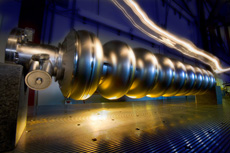
The ILC will use 16,000 superconducting cavities to accelerate the electrons and positrons to extremely high energies.
Beijing, China - The International Committee for Future Accelerators
(ICFA) today announced the release of the Reference Design Report (RDR)
for the International Linear Collider (ILC), a proposed future particle
accelerator.
Hurling some 10 billion electrons and their anti-particles, positrons,
toward each other at nearly the speed of light, beams in the ILC will
collide 14,000 times every second at extremely high energies - 500
billion-electronvolts (GeV). These spectacular collisions create an array
of new particles that will answer some of the most fundamental questions
about the nature of the universe, such as the origin of mass, dark matter,
dark energy, extra dimensions and beyond. The current 31-kilometre design
allows for an upgrade to a 50-kilometre, 1 trillion-electronvolt (TeV)
machine during the second stage of the project. Organised by the Global
Design Effort (GDE), a team of more than 60 scientists, the ILC is an
international endeavour that brings together more than 1000 scientists and
engineers from more than 100 universities and laboratories in over two
dozen countries.
Together with the Large Hadron Collider (LHC), scheduled to start
operating in 2007, scientists believe that the ILC will answer some of
science's greatest remaining questions about the nature of the universe.
With its high energy electron-positron collisions that provide very
precise data, the ILC will give scientists the information they need to
understand the Higgs mechanism, examine supersymmetric particles, probe
dark matter candidates and possibly find a way to reunite laws of nature
by discovering new forces. The scientific importance of both the LHC and
the ILC have been stressed by such influential reports as "Revealing the
Hidden Nature of Space and Time: Charting the Course for Elementary
Particle Physics" and "The European Strategy for Particle Physics."
Read more
|
Snow calls: They answer
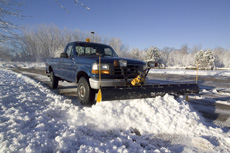
Plow-equipped pickup trucks are a key part of Fermilab's snow-removal
procedures.
When Tuesday's snowfall began, Roads and Grounds hit the ground plowing--and salting, sanding and shoveling. "Our guys were out there almost immediately when we saw the snowflakes," said Roads and Grounds Group Leader Dave Shemanske. Tackling the snow was a force of 16 full-time people, and four on-call people, using four large salt trucks, plows on pickup trucks and good old hand-held equipment and shovels.
Crews rotated through lunch time when the snow and traffic were heaviest. Some crews stayed through the afternoon rush hour "to make sure everyone got out of here," Shemanske added, with a small contingent staying as late as 8 p.m. Then another full-scale effort began Wednesday morning at 4 a.m. "It was just supposed to be a dusting, but it lasted from 9 a.m. until 8 p.m.," Shemanske said. "Usually when it's this cold, you don't have a high pressure system coming in with a snowstorm. But this time it did. We're always paying close attention to the weather. We have to."
Fermilab also has a special winter team that is available 24/7, and you can read about all the jobs they handle next week in Fermilab Today.
--Mike Perricone
|
Preparing for the Large Hadron Collider
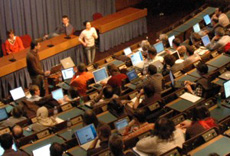
Close to 300 members of the WLCG collaboration attended a recent workshop at CERN. Those in attendance represented 27 countries and 86 sites.
Image courtesy of Will Venters.
Processing data for the Large Hadron Collider, the next-generation particle accelerator under construction at CERN, Switzerland, is one of the driving forces for development of grid technology.
The task of processing the 15 petabytes of data the LHC is predicted to generate each year falls to the Worldwide LHC Computing Grid Collaboration, which recently met at CERN for a week-long workshop in preparation for the start-up of the LHC later this year.
Read More
|
PhysOrg.com,
February 5, 2007:
A test for new physics, including string theory
Detractors of string theory have been deriding it for years, claiming that there is no way to test it. However, with a paper published in Physical Review Letters titled "Falsifying Models of New Physics via WW Scattering", that could change. Coauthors Jacques Distler at the University of Austin in Texas, Benjamin Grinstein from the University of California, San Diego, and Rafael A. Porto and Ira Z. Rothstein at Carnegie-Mellon University in Pittsburgh, Pennsylvania, address a way of falsifying some models of string theory in their Letter.
Read More |
|
|
Tautal exclusion
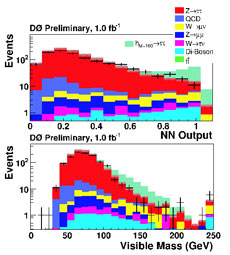
See graphic description below.*
Every day, we rely upon pattern recognition to help us navigate our world. Nature's supercomputer (your brain) is continuously collecting vast amounts of data from our surroundings to make decisions about our daily tasks: "Is my coffee hot?" or "Is that car slowing down?". Properly trained, the ability of the brain to recognize patterns is nearly unparalleled. Physicists model this technique using Artificial Neural Networks (ANNs), which combine many variables in ways similar to how your brain works. These ANNs make searches for rare processes much more robust. For example, identifying a friend in a crowd would be very hard relying on eye color alone. Adding hair color, height, and facial features makes the job easier and much more reliable.
DZero physicists have used an ANN to search for a neutral Higgs boson decaying into two tau leptons (taus are heavy brethren of electrons). One of the tau leptons is identified via its decay to a muon, while the other tau lepton decays to quarks. This experimental signature allows physicists to probe the theory of Supersymmetry. By relying upon the excellent coverage of the their muon detector system and the power of ANNs, DZero's search in the muon-tau channel has proven to be very powerful. In fact, this single search channel alone matches the sensitivity of the recently reported CDF search that combined several decay channels in roughly the same amount of data. In one inverse femtobarn of data, DZero physicists observe no excess of events compatible with a Higgs boson and set the tightest limits on Supersymmetric (MSSM) Higgs boson production ever.
With plans that will soon include tau decays to electrons, and with well over two inverse femtobarns of data already on tape, DZero is well placed to recognize any hint of Higgs boson decays to taus. However, in the region currently explored by DZero this channel is tautally excluded.
*Upper graphic: The output of the Artificial Neural Network for data (black points), the sum of the expected backgrounds (red), and a hypothetical signal for a Higgs Mass of 160 GeV, at a cross-section of 10pb. Lower graphic: The visible mass spectrum of the di-tau system is used as one of the several inputs to the ANN.

Above, from left: Stefan Soldner-Rembold and Mark Owen, both from the University of Manchester, contributed to this analysis. Below: The entire Run IIb dataset of DZero will be processed with a new and significantly improved version of the reconstruction code. Major contributors to this effort are, from left: Mike Hildreth, algorithms coordinator, University of Notre Dame; Mike Diesburg, reconstruction farm manager, Fermilab; Alan Jonckheere release manager, Fermilab; and Qizhong Li, reconstruction program manager, Fermilab.
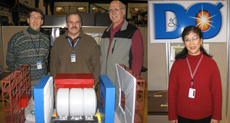
|
|
Family Open House
Get ready for the family open house this Sunday from 1:00 p.m. to 5:00 p.m. at Fermilab. There will be tours, a cryo-show, light-boxes, and a "Hair-Raising Electricity of the 19th Century" exhibit, and many other attractions. Read more here.
Nova Special
Tonight at 7:00 p.m., HD WTT11 will present the
NOVA special, "Forgotten Genius," which chronicles the life of Percy Julian. The grandson of Alabama slaves, Julian won worldwide acclaim for his research in chemistry.
Weight Watchers at Fermilab
The Recreation Office is looking for at least 18 people who are interested in forming a weight-watchers group at Fermilab. Member benefits include convenient, onsite meetings at noon; improved morale and team-building with your co-workers; guidance in weight management; and minimizing health care costs. Payment Options are available. Contact Jean at x2548 or Kathy at x 5427 if you are interested in participating. Deadline to contact the Recreation Office is Friday, February 23.
Brown Bag Seminar Tomorrow
Wellness Works will present a Brown Bag Seminar entitled "Eat, Sleep, Breathe and Move" on Friday, February 9, between noon and 1 p.m. in 1 West.
Upcoming Activities
|
|